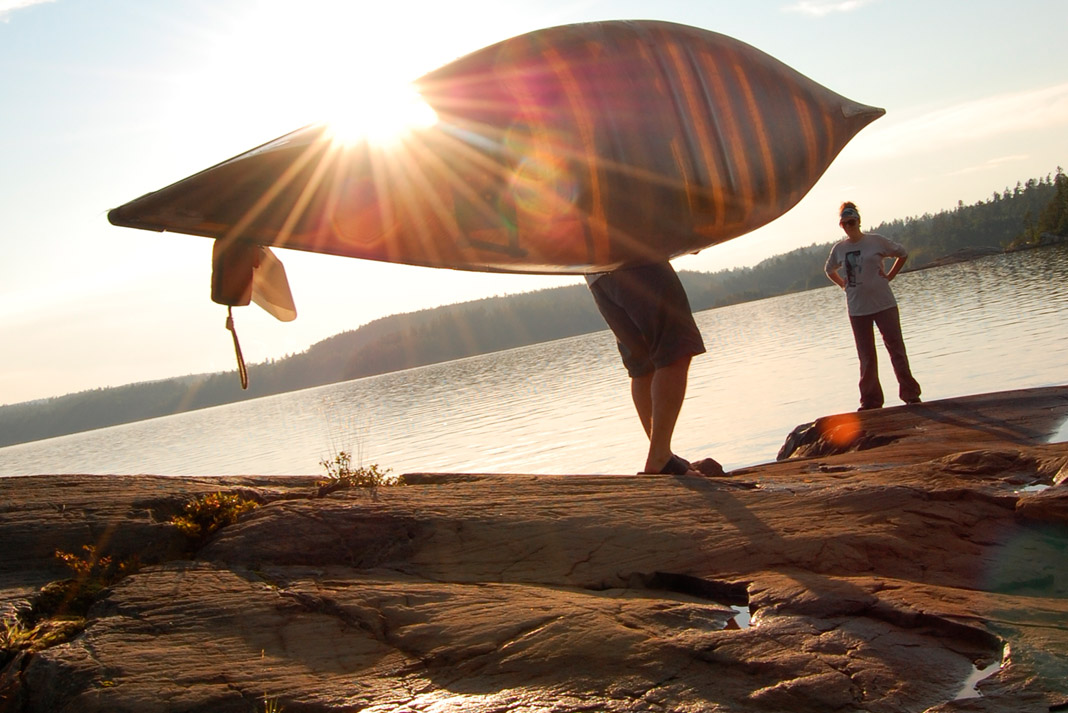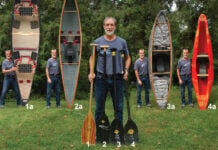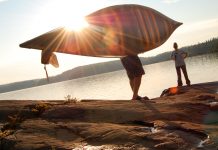So, you just bought a lightweight canoe. Good. Now, let’s make it heavier.It seems counter-intuitive, but while the featherweight layup of your canoe is designed to make portaging easier, it might actually be working against you on the water.
Most canoes are designed to paddle on a 180-degree plane, which means your canoe wants to sit flat on the water.
What’s ballast?
Placing extra weight—called ballast—correctly in your boat helps return the canoe to an even trim, especially when there’s a weight disparity between paddlers, or in the case of a solo paddler.
Ballast can correct the attitude of the hull along the keel line, and help keep the canoe on an even keel, whether lightly loaded or filled with gear.
By no means is the need for additional weight in a canoe a characteristic of a design flaw, nor a failure of material or manufacturing processes—it’s simply a by-product of just how light modern canoes have become.
With modern high-capacity, shallow-draft, high-freeboard, 30-to 40-pound hulls, the need for a little extra weight for optimum handling characteristics is more of a necessity than it used to be.
Adding ballast was common decades ago when canoes were used for work instead of play. Back then, the hulls weighed between 50 and 120 pounds. In those days, skilled woodsmen, guides, trappers, sportsmen and others who lived out of their canoes knew to add weight when they weren’t paddling loaded.
Fast forward to today, and canoes have shed a third of their weight, gained much larger capacities and are often expected to be paddled empty as often as they are loaded to the gunwales.

The benefits of ballast for canoe tripping
Adding ballast lowers the center of gravity of a canoe. By adding just 40 pounds, a solo paddler will drastically increase stability, and remove the reverse pendulum effect stokes tend to have on a hull.
Another benefit a paddler will notice is increased speed and better tracking—momentum and inertia will keep the canoe gliding between paddle strokes and make the hull less apt to be swayed from course by wind and wave.
You’re more likely to stay on your desired line and slice through waves.
The best way to add ballast to your canoe is by using water bags. Use two large drybags in a 20- and 30-liter size. Fill the 20-liter bag with water, roll the top down and clasp it shut.
Then, take the water-filled 20-liter bag and drop it into the 30-liter bag and clasp it shut. Water will leak out the of the first bag slowly, but not out of the second.
Lower the drybags into the center of the canoe. Adjust the bag fore and aft or side to side as necessary. With just 20 liters of water you will have gained 40 pounds of weight to use as a counterbalance, and in an unloaded boat you’ll notice a significant change in how your canoe handles.
When you hit land and it’s time to portage, dump the water out of your ballast bags, clip the empty bags to your canoe and portage your lightweight canoe.
Weight on the water but not the portage.| Feature Photo: Ontario Tourism








I’ve been telling myself for several years that my kayak tends to develop weather helm and the bow plows deeper in the water. Since the stern end is higher than the bow, the stern gets blown more then the bow, therefore swinging the boat into the wind.
My RobRoy solo Bell canoe is now in the shed with Minnesota lakes slowly icing over. But I’ll try this in May.
Thanks for the great article/suggestion.
Jerry Hendel. Fergus Falls, MN
I can understand the merit of adding a bit of ballast if the canoe has no cargo and you cannot effectively trim the canoe by shifting kneeling position(s). But tripping you can always shift the load or change the seating position to balance the trim. The more water the canoe displaces (the heavier the total load) the slower it will go. Ask a marathon racer of s/he ever adds ballast to a racing canoe?
I do agree that a water bag is better than a big rock. I am sure there have been canoes that end on the bottom of a lake because a big hunk of granite was used to help stop the canoe from weathercocking. Better to just move your butt closer to the bow.
My Wenonah Spirit II canoe maintains trim by having both seats adjustable sliders fore and aft. It would be interesting to perform objective experiments on canoe efficiency by using a lightweight electric motor set at constant rpm. Measure speed using a GPS with the canoe at various trim angles on a non-windy day. Then determine the effect of additional ballast weight on speed. With added ballast, the canoe must displace and “push out of the way” a larger volume of lake water. It would be interesting to know the relative drag effects of being one to three inches out of trim versus added ballast of 20, 40, 60, etc pounds of added weight. (or millimeters and kilograms for our friends up north that no longer think a system of measurement should be based on the Monarch’s shoe size)
Grammar nazi here.
Re: “reverse pendulum effect stokes tend to have”…
Edit: “stokes” should be “strokes”.
I have a 17’ Wenonah Encounter solo that is designed for carrying lots of camping cargo. The last time I did a multi day on Arkansas Buffalo, I carried a 50+ pound automobile battery under my sliding tractor seat to run my CPAP at night. That hull loves extra weight. In fact it’s pretty easy to fall out when totally empty of cargo. Can’t reach out an heel over safely. With a little more weight it’s easier to heel it over up on the tumble home bubble to turn it !!!
Novacraft Supernova Solo is a perfect example. Awesome tripping boat for wilderness ww. Paddles like a dream when food and gear is loaded with a good trim. When it is empty, it is as wobbly as a log – ballast – GOOD.
I agree with Ralph. This would make an interesting presentation at Canoecopia. You’re moving more mass if you increase the weight in the boat, which takes more energy. How much ballast is enough? How much is too much? How could you test & check this when you’re on the water?